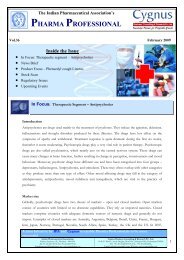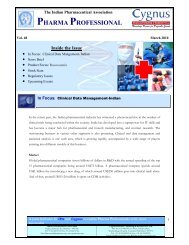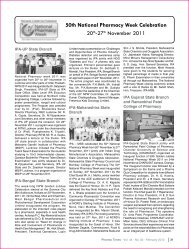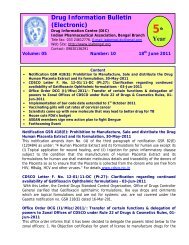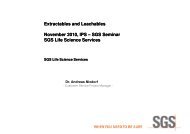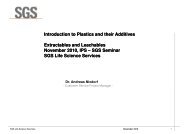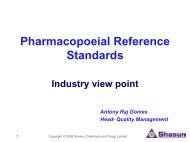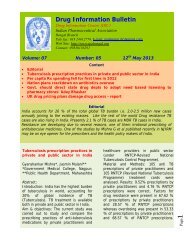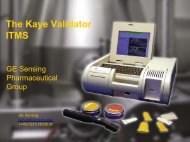assessment of over-the-counter medicine labels in india for Patient ...
assessment of over-the-counter medicine labels in india for Patient ...
assessment of over-the-counter medicine labels in india for Patient ...
You also want an ePaper? Increase the reach of your titles
YUMPU automatically turns print PDFs into web optimized ePapers that Google loves.
Article<br />
<strong>assessment</strong> <strong>of</strong> <strong>over</strong>-<strong>the</strong>-<strong>counter</strong> <strong>medic<strong>in</strong>e</strong> <strong>labels</strong><br />
<strong>in</strong> <strong>in</strong>dia <strong>for</strong> patient <strong>in</strong><strong>for</strong>mation<br />
Joshi M.P., Vaidya R.X., De Sousa E., Mangaonkar Sneha<br />
Goa College <strong>of</strong> Pharmacy, Goa.<br />
Introduction:<br />
In most countries <strong>of</strong> <strong>the</strong> world, <strong>the</strong>re exists a category <strong>of</strong> OTC<br />
(Over <strong>the</strong> Counter) <strong>medic<strong>in</strong>e</strong>s. However, <strong>in</strong> India, <strong>the</strong>re is no such<br />
designated category. As such, as a norm, <strong>in</strong> India, those <strong>medic<strong>in</strong>e</strong>s<br />
which do not, by law, require a prescription, are considered as nonprescription<br />
(or OTC) <strong>medic<strong>in</strong>e</strong>s. OTC <strong>medic<strong>in</strong>e</strong>s are an important<br />
component <strong>in</strong> health care, allow<strong>in</strong>g <strong>the</strong> freedom to <strong>the</strong> patient<br />
to self-medicate <strong>for</strong> treat<strong>in</strong>g m<strong>in</strong>or, common health problems, at<br />
lower costs and without hav<strong>in</strong>g to spend time and costs <strong>of</strong> visit<strong>in</strong>g<br />
a doctor.<br />
Although OTC <strong>medic<strong>in</strong>e</strong>s are supposed to be relatively safe,<br />
readily available and consumed by patients without a physician’s<br />
consent, it is very important that <strong>the</strong> patients have access to<br />
sufficient <strong>in</strong><strong>for</strong>mation to make an <strong>in</strong><strong>for</strong>med choice <strong>for</strong> <strong>the</strong> proper use<br />
<strong>of</strong> <strong>the</strong>se <strong>medic<strong>in</strong>e</strong>s. It is important to realize that like prescription<br />
<strong>medic<strong>in</strong>e</strong>s, even OTC <strong>medic<strong>in</strong>e</strong>s can cause unwanted side effects<br />
if not used correctly.<br />
The label <strong>of</strong> OTC <strong>medic<strong>in</strong>e</strong>s plays an important role <strong>in</strong> convey<strong>in</strong>g<br />
valuable <strong>in</strong><strong>for</strong>mation to <strong>the</strong> patient. We undertook a small study<br />
to evaluate whe<strong>the</strong>r <strong>medic<strong>in</strong>e</strong> <strong>labels</strong> <strong>of</strong> OTC <strong>medic<strong>in</strong>e</strong>s <strong>in</strong> India<br />
provide sufficient <strong>in</strong><strong>for</strong>mation to <strong>the</strong> patients (For choos<strong>in</strong>g <strong>the</strong>se<br />
OTC <strong>medic<strong>in</strong>e</strong>s, we used <strong>the</strong> criteria that <strong>the</strong>y were non-prescription<br />
<strong>medic<strong>in</strong>e</strong>s <strong>in</strong> India as well as most o<strong>the</strong>r countries).<br />
Objective: The objective <strong>of</strong> this study was to evaluate whe<strong>the</strong>r:<br />
1. OTC <strong>medic<strong>in</strong>e</strong> <strong>labels</strong> (primary) have adequate <strong>in</strong><strong>for</strong>mation <strong>for</strong><br />
patients to make proper self-medication choices.<br />
2. Additional <strong>in</strong><strong>for</strong>mation is available to patients through patient<br />
package <strong>in</strong>serts or on secondary packages (wherever<br />
applicable).<br />
3. The <strong>in</strong><strong>for</strong>mation provided is readable and can be clearly<br />
understood.<br />
Experimental Methods and Results:<br />
We took a total <strong>of</strong> 100 OTC <strong>medic<strong>in</strong>e</strong>s randomly from a<br />
pharmacy, c<strong>over</strong><strong>in</strong>g various categories <strong>of</strong> <strong>medic<strong>in</strong>e</strong>s and various<br />
dosage <strong>for</strong>ms like tablets, capsules, liquid orals and external<br />
preparations. The <strong>labels</strong> <strong>of</strong> <strong>the</strong>se <strong>medic<strong>in</strong>e</strong>s were <strong>the</strong>n assessed<br />
based on <strong>the</strong> “Drug Facts” label guidel<strong>in</strong>es provided by <strong>the</strong> United<br />
States Food and Drug Adm<strong>in</strong>istration (US FDA) <strong>for</strong> OTC <strong>medic<strong>in</strong>e</strong><br />
labell<strong>in</strong>g. The proposed labell<strong>in</strong>g <strong>in</strong>cludes various components, and<br />
we studied <strong>the</strong>se components as specified by Drug Facts standard<br />
labell<strong>in</strong>g <strong>for</strong>mat, with <strong>the</strong> follow<strong>in</strong>g results:<br />
1. Label to <strong>in</strong>clude : Active <strong>in</strong>gredient along with its strength :<br />
Results:<br />
All <strong>the</strong> 100 <strong>labels</strong> exam<strong>in</strong>ed mentioned <strong>the</strong> active <strong>in</strong>gredients<br />
along with <strong>the</strong>ir potency/strength.<br />
2. Label to <strong>in</strong>clude : Therapeutic category/purpose :<br />
55% <strong>of</strong> <strong>the</strong> <strong>labels</strong> did not disclose <strong>the</strong> <strong>the</strong>rapeutic category.<br />
3. Label to <strong>in</strong>clude : Uses /<strong>in</strong>dications <strong>for</strong> which <strong>medic<strong>in</strong>e</strong> can be<br />
utilized :<br />
Although a significant percentage (75%) mentioned <strong>the</strong> <strong>in</strong>dications<br />
<strong>for</strong> <strong>the</strong> <strong>medic<strong>in</strong>e</strong>, 25% <strong>of</strong> <strong>the</strong> <strong>labels</strong> failed to do so.<br />
4. Label to <strong>in</strong>clude: Warn<strong>in</strong>gs related to common adverse effects,<br />
drug <strong>in</strong>teractions, contra<strong>in</strong>dications, precautions, <strong>over</strong>dosage,<br />
when it is appropriate to seek medical advice and special<br />
conditions like pregnancy & breast-feed<strong>in</strong>g. This also <strong>in</strong>cludes<br />
admonitions to keep out <strong>of</strong> reach <strong>of</strong> children :<br />
Results:<br />
90% <strong>of</strong> <strong>the</strong> <strong>labels</strong> failed to enumerate <strong>the</strong> adverse effects <strong>of</strong> <strong>the</strong><br />
<strong>medic<strong>in</strong>e</strong>.<br />
86% did not state what is to be done <strong>in</strong> case <strong>of</strong> <strong>over</strong>dose<br />
92% gave no <strong>in</strong><strong>for</strong>mation regard<strong>in</strong>g usage <strong>in</strong> pregnancy and<br />
breastfeed<strong>in</strong>g<br />
87% <strong>of</strong> <strong>the</strong> <strong>labels</strong> did not mention <strong>of</strong> <strong>the</strong> possible drug <strong>in</strong>teractions,<br />
contra<strong>in</strong>dications and precautions.<br />
73% <strong>labels</strong> did not even advise to seek medical guidance.<br />
Only 36% <strong>labels</strong> mentioned that <strong>the</strong> <strong>medic<strong>in</strong>e</strong> is required to be<br />
kept out <strong>of</strong> <strong>the</strong> reach <strong>of</strong> children.<br />
5. Label to <strong>in</strong>clude : Directions <strong>in</strong>clud<strong>in</strong>g how much to be taken,<br />
dosage <strong>in</strong>terval, maximum dose allowed per day and <strong>the</strong> dose<br />
<strong>for</strong> children :<br />
Almost half <strong>of</strong> <strong>the</strong> <strong>medic<strong>in</strong>e</strong>s (46%) did not mention <strong>the</strong> amount to<br />
be used, while 34% did not mention <strong>the</strong> dos<strong>in</strong>g <strong>in</strong>terval. 85% <strong>of</strong><br />
<strong>the</strong> <strong>medic<strong>in</strong>e</strong>s did not state <strong>the</strong> maximum dose allowed. Out <strong>of</strong> <strong>the</strong><br />
15% which did state <strong>the</strong> maximum dose, 20% were ambiguous<br />
with <strong>the</strong> details. It was also observed that 70% <strong>of</strong> <strong>the</strong> <strong>medic<strong>in</strong>e</strong>s<br />
failed to specify <strong>the</strong> dose <strong>for</strong> children. Only 1 label <strong>in</strong>cluded<br />
<strong>in</strong>structions <strong>for</strong> use <strong>in</strong> Devanagiri script.<br />
6. Label to <strong>in</strong>clude: The product’s <strong>in</strong>active <strong>in</strong>gredients to help<br />
consumers avoid <strong>in</strong>gredients that may cause an allergic<br />
reaction.<br />
None <strong>of</strong> <strong>the</strong> <strong>labels</strong> <strong>in</strong>cluded <strong>the</strong> <strong>in</strong>active <strong>in</strong>gredients (o<strong>the</strong>r than<br />
say<strong>in</strong>g <strong>in</strong> some cases, <strong>the</strong> solvent/base used).<br />
7. Label to <strong>in</strong>clude: Storage conditions.<br />
Even though a large percentage (88%) <strong>of</strong> <strong>the</strong> <strong>labels</strong> provided<br />
<strong>the</strong> storage conditions, 64% <strong>of</strong> <strong>the</strong>m were imprecise and difficult<br />
to understand. Nearly 85% <strong>of</strong> <strong>the</strong> <strong>labels</strong> were found without a<br />
specific temperature. Fur<strong>the</strong>rmore, storage conditions were <strong>of</strong>ten<br />
mentioned us<strong>in</strong>g terms which <strong>the</strong> common man are not familiar<br />
with. The exact temperature was rarely mentioned.<br />
*Email Id: rajxvaidya@gmail.com<br />
Pharma Times - Vol. 44 - No. 06 - June 2012 20
8. Besides, we also assessed <strong>the</strong> label <strong>for</strong> 2 more criteria :<br />
1. Label to <strong>in</strong>clude: Legibility to f<strong>in</strong>d out whe<strong>the</strong>r <strong>the</strong> label is easily<br />
readable, read with difficulty or with <strong>the</strong> aid <strong>of</strong> a magnify<strong>in</strong>g<br />
glass.<br />
40% <strong>of</strong> <strong>the</strong> <strong>medic<strong>in</strong>e</strong> <strong>labels</strong> were clearly read only with <strong>the</strong> aid <strong>of</strong><br />
a magnify<strong>in</strong>g glass as <strong>the</strong> font size was too small. 22% <strong>of</strong> drug<br />
<strong>labels</strong> were read with difficulty leav<strong>in</strong>g just around 38% which<br />
could be read easily. This suggests that 62% <strong>of</strong> <strong>the</strong> <strong>labels</strong> are<br />
read with much ef<strong>for</strong>t.<br />
1. Label to <strong>in</strong>clude: Additional <strong>in</strong><strong>for</strong>mation through patient<br />
package <strong>in</strong>serts, <strong>in</strong><strong>for</strong>mation on secondary packages (wherever<br />
applicable): <strong>Patient</strong> package <strong>in</strong>serts are useful <strong>for</strong> provid<strong>in</strong>g<br />
additional <strong>in</strong><strong>for</strong>mation to <strong>the</strong> patient.<br />
Out <strong>of</strong> <strong>the</strong> 100 <strong>medic<strong>in</strong>e</strong>s exam<strong>in</strong>ed, only 3 <strong>in</strong>cluded a patient<br />
package <strong>in</strong>sert. Many a times, secondary packag<strong>in</strong>gs <strong>of</strong><br />
<strong>medic<strong>in</strong>e</strong>s are also given to <strong>the</strong> patient as additional protection<br />
<strong>for</strong> <strong>the</strong>ir <strong>medic<strong>in</strong>e</strong>s or as attractive packs. These secondary<br />
packages can also be used to convey valuable <strong>in</strong><strong>for</strong>mation to <strong>the</strong><br />
patient. In 56% <strong>of</strong> <strong>the</strong> cases, a secondary package was found<br />
to be available to <strong>the</strong> patient, yet only 36% <strong>of</strong> <strong>the</strong>m gave more<br />
<strong>in</strong><strong>for</strong>mation on its label than <strong>the</strong> primary package.<br />
Ano<strong>the</strong>r f<strong>in</strong>d<strong>in</strong>g was that 76% <strong>of</strong> <strong>the</strong> <strong>medic<strong>in</strong>e</strong>s were not<br />
advertised. On <strong>the</strong> positive side, all <strong>the</strong> 100 <strong>labels</strong> did provide<br />
required details <strong>of</strong> manufacture and expiry <strong>of</strong> <strong>the</strong> <strong>medic<strong>in</strong>e</strong>s. These<br />
are also crucial requirements <strong>for</strong> <strong>medic<strong>in</strong>e</strong> safety.<br />
Conclusion:<br />
The study thus revealed that <strong>the</strong>re is limited space available<br />
on <strong>the</strong> primary package <strong>of</strong> <strong>medic<strong>in</strong>e</strong>s. In cases where <strong>the</strong>re was a<br />
secondary package, and a scope <strong>for</strong> provid<strong>in</strong>g additional <strong>in</strong><strong>for</strong>mation<br />
was available, yet <strong>the</strong> <strong>in</strong><strong>for</strong>mation was not provided. The study also<br />
revealed that <strong>the</strong> required <strong>in</strong><strong>for</strong>mation provided on OTC <strong>medic<strong>in</strong>e</strong><br />
<strong>labels</strong> <strong>in</strong> India is usually quite <strong>in</strong>sufficient <strong>for</strong> <strong>the</strong> patient to make a<br />
“responsible” decision <strong>for</strong> self-medication.<br />
Suggestions:<br />
There is a clear need <strong>for</strong> a specific OTC category <strong>of</strong> <strong>medic<strong>in</strong>e</strong>s <strong>in</strong><br />
India, with clear-cut laid down guidel<strong>in</strong>es <strong>for</strong> <strong>the</strong>ir complete labell<strong>in</strong>g.<br />
The label <strong>of</strong> OTC <strong>medic<strong>in</strong>e</strong>s should conta<strong>in</strong> sufficient <strong>in</strong><strong>for</strong>mation,<br />
<strong>for</strong> example on l<strong>in</strong>es with <strong>the</strong> Drug Facts label recommended by<br />
US FDA, so that <strong>the</strong> patient gets sufficient <strong>in</strong><strong>for</strong>mation.<br />
There is also a need to considerably improve and organize <strong>the</strong><br />
labell<strong>in</strong>g <strong>of</strong> OTC <strong>medic<strong>in</strong>e</strong>s, so that <strong>the</strong>y are simple, straight<strong>for</strong>ward,<br />
and easy to read. The <strong>labels</strong> should also be pr<strong>in</strong>ted <strong>in</strong> languages<br />
patients will comprehend. If critical <strong>in</strong><strong>for</strong>mation cannot be <strong>in</strong>cluded<br />
on <strong>the</strong> primary label, suitable patient package <strong>in</strong>serts should be<br />
<strong>in</strong>cluded with <strong>the</strong> <strong>medic<strong>in</strong>e</strong>.<br />
Bibliography:<br />
1. OTC Drug Fact Label [<strong>in</strong>ternet] 2009 [updated 2009 May 28].<br />
Available from: http://www.fda.gov/Drugs/ResourcesForYou/<br />
Consumers/ucm143551.htm<br />
2. AHFS Drug In<strong>for</strong>mation. USA: ASHP; 2004.<br />
Book Review<br />
Title: Edit<strong>in</strong>g Pharmacy<br />
Author - Dr. B.D. Miglani<br />
Publisher - Association <strong>of</strong><br />
Pharmaceutical Teachers <strong>of</strong><br />
India, Bangalore, Karnataka.<br />
I am very happy that <strong>the</strong><br />
Association Pharmaceutical<br />
Teachers <strong>of</strong> India (APTI) has<br />
brought out “Edit<strong>in</strong>g Pharmacy”<br />
authored by Dr. B.D. Miglani.<br />
This book has been written to<br />
recapture and preserve <strong>the</strong><br />
editorials which Dr. Miglani contributed to Indian Journal <strong>of</strong><br />
Hospital Pharmacy. It is, no doubt, an important publication by<br />
a dist<strong>in</strong>guished pharmacist.<br />
Right from his jo<strong>in</strong><strong>in</strong>g <strong>for</strong> a B.Pharm Degree <strong>in</strong> Punjab University,<br />
and, <strong>the</strong>reafter, his 3 months tra<strong>in</strong><strong>in</strong>g <strong>in</strong> dispensary at <strong>the</strong> Victoria<br />
Jubilee Hospital attached to Medical College at Amritsar and<br />
<strong>the</strong>n work<strong>in</strong>g as Chief Pharmacist at <strong>the</strong> Lady Hard<strong>in</strong>ge Medical<br />
College Hospital <strong>for</strong> a decade, a noble thought <strong>in</strong>spired Dr.<br />
Miglani to upgrade <strong>the</strong> standard <strong>of</strong> Pharmacy and create a better<br />
image <strong>of</strong> <strong>the</strong> pharmacists <strong>in</strong> community. In December 1963, at<br />
<strong>the</strong> time <strong>of</strong> <strong>the</strong> 15 th Pharmaceutical Congress <strong>in</strong> Pilani, it was<br />
largely to his call; it was decided to organize a <strong>for</strong>um <strong>of</strong> Indian<br />
Hospital Pharmacists’ Association (IHPA) with whom he had his<br />
lifelong attachment. The book has captured <strong>the</strong> editorials by Dr.<br />
B.D. Miglani from May 1964 to <strong>the</strong> end <strong>of</strong> 2007.<br />
The editorials c<strong>over</strong>ed a vast array <strong>of</strong> subjects like various<br />
committees <strong>for</strong>med both at central and state levels on Hospital<br />
Pharmacy, establishment <strong>of</strong> NIPER, issues perta<strong>in</strong><strong>in</strong>g to<br />
amendments to <strong>the</strong> Pharmacy Act, Drugs’ and Cosmetics Act<br />
and Implementation <strong>of</strong> Section 42 <strong>of</strong> Pharmacy Act. Through<br />
<strong>the</strong>se editorials he made <strong>for</strong>ceful appeals <strong>for</strong> better pay scales<br />
<strong>for</strong> Hospital Pharmacists. The editorials drew attention to topics<br />
perta<strong>in</strong><strong>in</strong>g to academic, scientific and technical subjects. Dur<strong>in</strong>g<br />
<strong>the</strong> large span <strong>of</strong> <strong>over</strong> 4 decades, <strong>the</strong>se editorials portray <strong>the</strong><br />
history <strong>of</strong> Pharmaceutical development <strong>in</strong> India thus mak<strong>in</strong>g this<br />
book a unique and <strong>in</strong>valuable history document.<br />
Many developments happened to <strong>the</strong> pr<strong>of</strong>ession <strong>of</strong> pharmacy <strong>in</strong><br />
India s<strong>in</strong>ce India’s <strong>in</strong>dependence and Dr. B.D. Miglani’s unique<br />
strength has been to voice his frank op<strong>in</strong>ion on each landmark<br />
event through <strong>the</strong>se editorials. The fasc<strong>in</strong>at<strong>in</strong>g range <strong>of</strong> subjects<br />
c<strong>over</strong>ed <strong>in</strong> <strong>the</strong> book has <strong>in</strong>fluenced many to make hospital<br />
pharmacy as career.<br />
Dr. B.D. Miglani’s unique contribution to understand<strong>in</strong>g<br />
<strong>of</strong> hospital pharmacy is <strong>of</strong> highest possible level and <strong>the</strong><br />
pr<strong>of</strong>ession will always rema<strong>in</strong> grateful to him <strong>for</strong> his exemplary<br />
leadership.<br />
Reviewed by:<br />
Mr. Prafull D. Sheth,<br />
FIP Vice President &<br />
Pr<strong>of</strong>essional Secretary, SEARPharm Forum<br />
Pharma Times - Vol. 44 - No. 06 - June 2012 21



